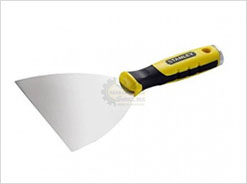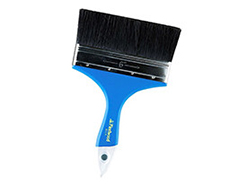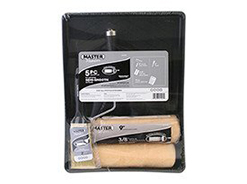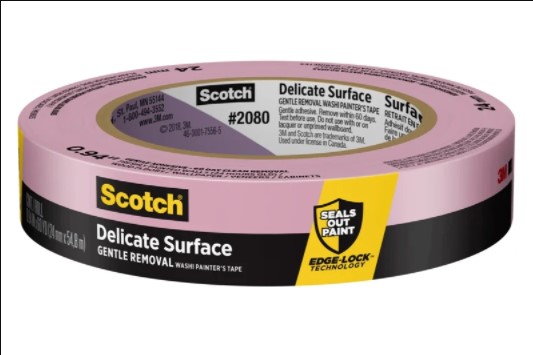 S2K Commerce - Products Dropdown
S2K Commerce - Products Dropdown
 Web Content Viewer
Web Content Viewer

How to Paint a Room Like a Pro
If this is your first time painting a room you're in luck. It's a great project for any novice do-it-yourselfer. With the right tools and advice, you can give any room in your home an instant update without spending a lot of time or money.
Step 1: Prepare the Room
Before you begin, remove hardware and fixtures from the walls and ceilings with a screwdriver. Remember to turn off the breaker or fuse for the room before working with electrical components. Remove electrical switch plates, cable TV outlets, phone jack covers, curtains and decorations and cover edges with painter's tape. It's best to move any furniture you can to another room. If that's not an option, move your furniture to the center of the room and cover it with tarps or drop cloths.
Before you paint, remember to prepare the walls. Wash the wall surface using a damp cloth, mild detergent and water. Patch any holes and wall damage with spackling compound. Scrape off flaky paint using a putty knife.
Step 2: Prime Walls
Always prime if you're painting a lighter color over a darker one. On flat-painted walls with minor repairs, you may only need to spot prime. For walls with larger areas of patching plaster, use True Value EasyCare Ultra Premium Interior Primer/Sealer.
Priming doesn't require as much care as painting, but you'll use the same technique. Start with the ceiling, first covering the perimeter and unpainted areas around the fixtures. Moving in 6'-square sections, use a series of overlapping "W" strokes from right to left, then back from left to right. Spread the primer evenly using horizontal strokes. Continue in 6'-square sections until the entire surface is primed.
HELPFUL TIP
Tint your primer to match as close as possible the color that you’re going to be painting. Tinted primers improve the end result of your painting project; they work with the finish coat color to boost color accents for a better-looking job. Ask a Certified Color Expert at your local True Value hardware store for tinting help. They can do it for you in the store.
HELPFUL TIP
Use synthetic brushes, such as polyester or nylon, with latex paints. Natural bristle brushes work best if you're using oil-based or alkyd-based paints.
Step 3: Apply Ceiling Brushwork
Mask the perimeter of the ceiling with painter's tape. Next, "cut in," or outline, the entire room with a brush to reach the areas a roller can't. An angled sash brush works well for cutting into corners. Get as close as you can, applying the paint about a 1/4" from the edge of the surface. On your second pass, apply more pressure to carefully push the paint into place.
HELPFUL TIPS
To roll closer to edges without making a smeary mess, put your hand inside a plastic bag and slide the paint-soaked roller so it extends about one inch past the end of the roller handle cage. This allows you to roll right up to edges and cover any brush stroke messes.
When doing ceiling brushwork, it's easier to pour paint into a smaller can like a coffee can. That way you don't have to lug a heavy paint can up the ladder with you.
Step 4: Painting the Ceiling and Walls
Start with the ceiling before painting your walls. Always use a quality latex paint like True Value EasyCare Ultra Premium Interior Paint. Use the same technique as priming your ceiling and walls, moving in 6'-square sections across the ceiling and walls. Be sure to feather the edges of the squares, using less pressure when applying paint at the edges of the square. This will keep the finish even and prevent any lines where the paint overlaps from another section. Keep working with the squares until the surface is completely painted. Without adding paint to the roller, use light strokes to re-roll from the bottom of the wall to the top (or across the ceiling) to make sure everything is even.
If your paint is any other finish than flat, you should go over the entire surface (for very large areas, do two square sections at a time) once again with one-directional, overlapping, non-diagonal strokes to blend the paint.
HELPFUL TIP
Be sure to choose a roller cover that suits the surface texture. If you have a "popcorn" or textured ceiling, use a roller with thicker pile. Your True Value associate can help you find the right roller for your paint project.
Step 5: Apply Wall Brushwork
Use the brush to do wall brushwork wherever your roller couldn't reach. Dip the bristles no more than an inch into the paint and go over areas in the corners and next to the doors, windows and molding.
Step 6: Paint Second Coat
The first coat doesn't have to be totally dry, but you'll get better coverage the longer you let the surface dry. Paint the second coat in the same way you painted the first.
Step 7: Paint the Trim, Doors and Windows
Paint all the trim areas around the doors and windows with True Value EasyCare Ultra Premium Interior Paint. For base molding, run blue painter's tape along the floor to prevent any drips.
Before painting a door, you need to take off the handle or knob and the strike plate. If you have inset panels, paint those first, followed by the horizontal bars and then the vertical.
For windows, you need to move the outside sash—the top part of the window—down. Move the inside sash up. Now you can paint the bottom part of the outside sash. Push this back up when you've finished painting it. Pulling down the inside sash, paint the top part of the outside sash and the inside sash. Make sure you open and close the window occasionally as the paint is drying so the window doesn't stick.
HELPFUL TIP
If you get paint on the glass, just wait a day and use a one-sided razor blade to scrape it off.
Step 8: Clean Up
Good brushes will last for many years if you treat them well. Use a brush comb to separate bristles that stick together near the heel of the brush. Rinse the brush out in either water or paint thinner. When the water or paint thinner runs clear, thoroughly shake out any excess liquid. Put the brush back in its protective sleeve or hang it on a nail or hook.
SAFETY ALERT!
Don't throw used paint thinner down the drain. Some states don't even allow it. Find out where and how you can properly dispose of any used paint thinner.
Pick up the drop cloths and replace the furniture. Once the paint is dry, replace the switch and outlet plates, the ceiling fixtures cover plate and the door hardware.
HELPFUL TIP
Save any remaining paint for touch-ups. For bigger touch-ups, you'll want to remember your paint color. Before you replace the cover plates, put a piece of masking tape on the back. Write the name of the paint you used in that room and you'll have the name of the paint handy whenever you have to do touch-ups.
Congratulations! Take a step back and admire your work. With a little time and effort, you've transformed your home by adding color to your walls.
Source: True Value




